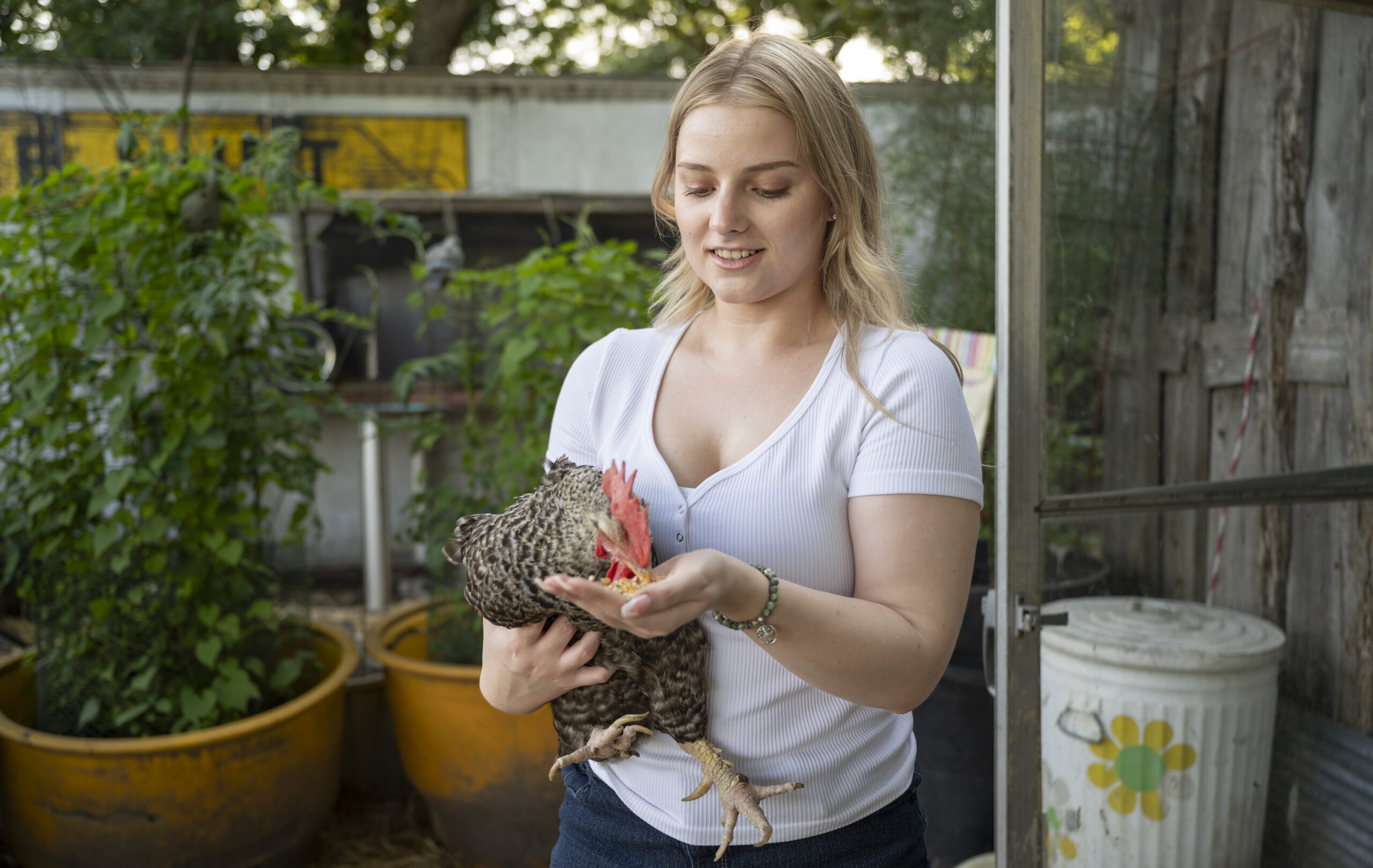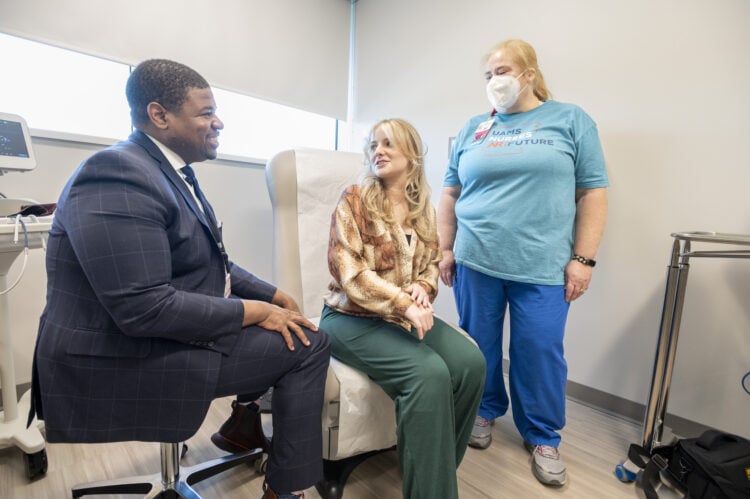View Larger Image

Jolee Camp, here on her parents' farm, is grateful for having access to a cutting-edge device study at UAMS that has cured her disabling back condition.
Image by Evan Lewis
Breakthrough Device Implant at UAMS Restores Young Woman’s Pain-Free Life
| Jolee Camp was a thriving 15-year-old who dreamed of becoming a professional dancer and enjoyed hunting, fishing and working on her family’s farm in Lonoke when she was suddenly disabled by unexplained low back pain.
“She spent her senior year in a wheelchair,” said her mother, B.J. Camp, who took her daughter from doctor to doctor for six years in the futile pursuit of a diagnosis and an effective treatment.
Jolee Camp’s life-changing break came two years ago, at age 20, when she saw UAMS pain specialist Johnathan Goree, M.D. He not only diagnosed her condition, he offered a potential long-term solution: a promising new implantable device available as part of a research study he is leading at UAMS.
The news was overwhelming for Camp and her mother.

Johnathan Goree, M.D. (left), was the first doctor able to diagnose Jolee Camp’s back condition and offer a successful treatment option. Camp, center, credits Goree and Susan Smith Dodson, MBA (right), clinical research coordinator, with ensuring her speedy enrollment in the device study after she turned 21. (Photo by Evan Lewis)
“We both just started crying,” said Camp, who had endured numerous injections, nerve ablations, pain medications that sickened her, and doctors who doubted her. “I was just so thankful that I got to see Dr. Goree. He fought for me when other doctors were telling me it was in my head, that I was making it up.”
Goree, who leads the UAMS Pain Clinic, said her journey is like that of many patients who finally make it to his clinic after years of suffering.
“They’ve had physicians tell them the pain is in their head, and so I can only imagine the kind of emotional trauma that Jolee experienced,” he said.

Jolee Camp was excited to be able to walk across the stage to receive her college diploma, something she didn’t expect to do before receiving the implanted device.
The Diagnosis
Goree diagnosed Camp’s condition as multifidus dysfunction. People who have it experience weakness and atrophy of the multifidus muscles in the lower back, which help support the lumbar spine.
Although unusual for someone as young as Camp, it’s a condition that Goree and his team see routinely at the Pain Clinic.
After injuring her multifidus muscle at some point, he explained, Camp’s exceptionally strong core likely helped stabilize her spine as her injured multifidus muscle continued to weaken and shrink as her activity level declined.
“Eventually your lack of multifidus back core muscles got to the point where you couldn’t compensate for it anymore,” Goree told the Camps during a recent visit to The Orthopaedic and Spine Hospital at UAMS.
Without an accurate diagnosis, Camp’s previous doctors prescribed injections and nerve ablations that provided only temporary relief, as well as pain medications and muscle relaxers that helped her sleep but also made her sick.
Physical therapy also failed because the muscle wasting was too severe to overcome.
The Solution
Goree is the UAMS principal investigator for the multisite study of the first and only Food and Drug Administration (FDA)-approved implantable neurostimulation device that can restore muscle and relieve chronic low back pain. The study, “ReActiv8 Stimulation Therapy vs Optimal Medical Management: A Randomized Evaluation (RESTORE),” is supported by the UAMS Translational Research Institute.
The device, ReActiv8®, developed by Mainstay Medical, includes a small generator implanted under the skin in the lower back that delivers electrical stimulation through wire leads that are hooked into the multifidus muscle. The stimulation interrupts the pain and causes the muscles to contract, which also makes them grow and strengthen so they can support the spine.
Although approved by the FDA, ReActiv8® continues to be researched with the RESTORE Trial to provide the evidence necessary for insurance companies to offer coverage.
At the time she heard about the device study, Camp was in her junior year at Arkansas Tech University, which she attended remotely because of her condition. She graduated in 2023 with degrees in criminal justice and political science and was on the Dean’s List all four years. Her academic skills came in handy when she needed to learn more about the device.
“I researched everything that I possibly could about it,” she said. “I looked into the studies that they did in the United Kingdom because the devices were approved over there, first. I looked at a lot of the testimonials and the surgery process and how long the recovery would be and all of that stuff.”
She concluded that it had a good chance of helping her, and she enthusiastically agreed to be a study participant.
While Goree could not make Camp any promises about the device’s effectiveness, he thought she would be an ideal candidate. The only hold up was her age; she would have to be 21 to enroll, and she was eight months away from that milestone.
Goree and Susan Smith Dodson, MBA, BSN, RN, the study’s clinical research coordinator at the Translational Research Institute, didn’t want Camp to wait any longer than necessary, so they worked with Mainstay to ensure all the preliminary hurdles were cleared to help expedite enrollment after her August birthday.
“Both of us really understood how uncomfortable she was, and we wanted to make sure that she had this option as soon as she could,” Goree said. “Also, the longer we waited, the worse her pain would get because that loss of muscle would continue.”
Camp was also fortunate to be randomly assigned to the device treatment group rather than the study’s control group. Had she been in the control group, she would have had to wait another year to receive the implant.
“I waited for eight months to turn 21 and then within the course of three months, I had the surgery,” she said.
‘Super Motivated’
The Nov. 14, 2022, surgery, performed by Goree and his colleague and co-investigator G. Lawson Smith, M.D., went as planned. Camp, determined to have a successful outcome, was a model patient and study participant, Goree and Dodson said.
She dutifully followed the recovery guidelines and study protocol, activating the device twice a day. At 6 a.m., she would lie on her stomach and run the stimulator for 30 minutes, then repeat it at 4 p.m.
“She was super compliant, super motivated,” Goree said.
“I adhered to it strictly because I wasn’t going to waste this opportunity after all the years of just having to fight and fight and fight,” she said. “Dr. Goree fought for me to get it, and I wasn’t going to waste his efforts.”
Goree cautioned Camp that it would take time to see results. Like building muscles at the gym, it doesn’t happen overnight, he said.
Instant Relief
While the muscle building would take time, the device provided instant relief during the 30-minute stimulation sessions. Although pain returned afterward, the intensity was diminished, she said.
At her three-month follow-up visit, Camp reported at least a 20% pain reduction and was able to quit all prescription pain medication.

Jolee Camp, here at her family’s farm, said UAMS’ Johnathan Goree, M.D., “gave me my life back.” (Photo by Evan Lewis)
“I was so excited just to have any relief, and then at about the six-month mark I had about 50% relief,” she said. “I was able to start going out with my friends, and I could drive the car for more than an hour, and I could walk more than 10 minutes without feeling like I had to sit down, and I was getting eight hours of sleep.”
Attending her college graduation was a seminal accomplishment.
“I was able to wear heels, and I was able to walk across the stage. It was just amazing, and I never thought I was going to be able to do that before,” she said.
She was excited to tell Goree and Dodson about her progress at her six-month visit a few weeks later.
“They have been with me since I’ve been in college, so it was a really big thing for me to be able to do,” she said.
At one year, she was nearly pain free and reported the same result during her 18-month follow-up visit.
She told Goree that she wakes up in the mornings pain free, although depending on what she has done on a given day, her pain in the evening may rate a five or six on a 1-10 scale.
“It’s nowhere near that 10 that I felt every single day, and I’m not taking any pain medication at all right now,” she said.
In addition to rejoining friends and resuming her many hobbies, she has held as many as three jobs at one time, including as an in-home health care provider, a waitress and an optician. She hopes to start a career in the criminal justice field, possibly in cybersecurity.
“I have so much gratitude for Dr. Goree,” she said. “He gave me my life back.”
Her final follow-up visit will be at the two-year mark this fall, and she can choose to keep the device at no cost.
“I plan on keeping it as long as you’ll let me have custody of it,” she told Goree.
Goree assured her that she could, and he said the generator battery should last seven to 10 years.
Inspired Care
Camp said she is also grateful for the cutting-edge medical technology that helped her return to a normal life, especially so close to home.
“My parents and I looked into going to all sorts of places, like the Mayo Clinic and Johns Hopkins,” she said. “But then there’s also trying to figure out how to afford it. I’m very, very thankful because I live about 30 minutes from UAMS.”
Goree said outcomes such as Camp’s are what inspire him to seek the latest treatments, techniques and promising therapeutics.
“This is why I do what I do,” he said.
The device has delivered similarly exciting results for three other study participants at UAMS and exemplifies the role of research in achieving his goals for patients.
“Research gives Arkansans access to cutting-edge therapies,” Goree said, noting that new treatment innovations have traditionally been available only at health centers on the East and West Coasts.
“I think we have now built a center where a lot of the new innovation is happening in Arkansas,” he said. “It helps patients here and around the world because we are helping to bring new techniques and treatments to the market. Thanks to this research, this device is now covered by many insurances and we are happy to offer it to patients in our clinic.”
The Translational Research Institute is supported by a Clinical and Translational Science Award funded by the National Institutes of Health’s National Center for Advancing Translational Sciences, award number UL1 TR003107.